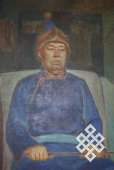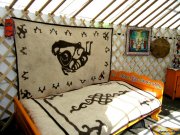|
|
|
|
|
|
|
1 September 2010 | Views: 2595 | Comments: 0 |
|
|
 M.B.Kenin-Lopsan's portrait by V.S.Samiy“God of fire, give us happiness, please, fire, give us happiness and prosperity in the yurt…” – the rhythmically bewitching voice of a St. Petersburg actress sounds throughout the conference auditorium of the National Museum. On the screen is a photograph of the shamaness in ecstasy of the “kamlanie”. When on the background of the sound of her drumming, an image of Tuvan steppe materializes through the flames of the fire, it seem that you, the spectator, are also departing on a journey about which the intermediary is chanting: We will swim over the river that is forbidden to cross, we will force the pass which it is forbidden to ascend”. This is the first time that the algyshes of Tuvan shamans sound in Russian language in this hall. The first time that a photograph, thanks to elegant montage is transformed into a video film, which starts with the text: “In our huge Russia, there is an extremely mysterious and beautiful country. Its mighty mountain ridges with eternal snow touch the heavens. Between the ice and the deserts tower the mountains, covered in virginal forests.” M.B.Kenin-Lopsan's portrait by V.S.Samiy“God of fire, give us happiness, please, fire, give us happiness and prosperity in the yurt…” – the rhythmically bewitching voice of a St. Petersburg actress sounds throughout the conference auditorium of the National Museum. On the screen is a photograph of the shamaness in ecstasy of the “kamlanie”. When on the background of the sound of her drumming, an image of Tuvan steppe materializes through the flames of the fire, it seem that you, the spectator, are also departing on a journey about which the intermediary is chanting: We will swim over the river that is forbidden to cross, we will force the pass which it is forbidden to ascend”. This is the first time that the algyshes of Tuvan shamans sound in Russian language in this hall. The first time that a photograph, thanks to elegant montage is transformed into a video film, which starts with the text: “In our huge Russia, there is an extremely mysterious and beautiful country. Its mighty mountain ridges with eternal snow touch the heavens. Between the ice and the deserts tower the mountains, covered in virginal forests.”
|
|
|
|
|
|
Natalia Bogdanovskaya. Tuvinskaya Pravda. Translated by Heda Jindrak |
|
|
|
|
|
|
|
|
1 September 2010 | Views: 7823 | Comments: 0 |
|
|
 On the day of the Republic, August 15 in the morning, in the hall of the National Museum of RT, a “round table” conference “Tradition and today in the artistic use of felt” took place. It was a meeting of enthusiastic people; who came not just from Tuva, but also from various regions of Russia. They were all united by by love of this amazing material which came to the 21st century from the depths of history. If you ask an average young city dweller what objects made of felt he can think of, expect a short answer – felt boots and house slippers, and that only in the best case. But this undeservedly almost forgotten woolen material is now coming out of the shadow of oblivion, and is becoming again attractive to artists, artisans and craftsmen. On the day of the Republic, August 15 in the morning, in the hall of the National Museum of RT, a “round table” conference “Tradition and today in the artistic use of felt” took place. It was a meeting of enthusiastic people; who came not just from Tuva, but also from various regions of Russia. They were all united by by love of this amazing material which came to the 21st century from the depths of history. If you ask an average young city dweller what objects made of felt he can think of, expect a short answer – felt boots and house slippers, and that only in the best case. But this undeservedly almost forgotten woolen material is now coming out of the shadow of oblivion, and is becoming again attractive to artists, artisans and craftsmen.
|
|
|
|
|
|
Marina Kenin-Lopsan, Tuvinskaya Pravda, tuva.asia, translated by Heda Jindrak |
|
|
|
|
|
|
